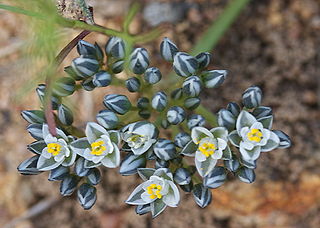
Mentha is a genus of plants in the family Lamiaceae. The exact distinction between species is unclear; it is estimated that 13 to 24 species exist. Hybridization occurs naturally where some species' ranges overlap. Many hybrids and cultivars are known.

Bulbophyllum is a genus of mostly epiphytic and lithophytic orchids in the family Orchidaceae. It is the largest genus in the orchid family and one of the largest genera of flowering plants with more than 2,000 species, exceeded in number only by Astragalus. These orchids are found in diverse habitats throughout most of the warmer parts of the world including Africa, southern Asia, Latin America, the West Indies, and various islands in the Indian and Pacific Oceans. Orchids in this genus have thread-like or fibrous roots that creep over the surface of trees or rocks or hang from branches. The stem is divided into a rhizome and a pseudobulb, a feature that distinguished this genus from Dendrobium. There is usually only a single leaf at the top of the pseudobulb and from one to many flowers are arranged along an unbranched flowering stem that arises from the base of the pseudobulb. Several attempts have been made to separate Bulbophyllum into smaller genera, but most have not been accepted by the World Checklist of Selected Plant Families.

The Asclepiadoideae are a subfamily of plants in the family Apocynaceae. Formerly, they were treated as a separate family under the name Asclepiadaceae, e.g. by APG II, and known as the milkweed family.

The Combretaceae, often called the white mangrove family, are a family of flowering plants in the order Myrtales. The family includes about 530 species of trees, shrubs, and lianas in ca 10 genera. The family includes the leadwood tree, Combretum imberbe. Three genera, Conocarpus, Laguncularia, and Lumnitzera, grow in mangrove habitats (mangals). The Combretaceae are widespread in the subtropics and tropics. Some members of this family produce useful construction timber, such as idigbo from Terminalia ivorensis. The commonly cultivated Quisqualis indica is now placed in the genus Combretum. Many plants in the former Quisqualis genus contain the excitotoxin quisqualic acid, a potent AMPA agonist.

Joseph Marie Henry Alfred Perrier de la Bâthie was a French botanist who specialized in the plants of Madagascar.

Linaceae is a family of flowering plants. The family is cosmopolitan, and includes about 250 species in 14 genera, classified into two subfamilies: the Linoideae and Hugonioideae. Leaves of the Linaceae are always simple; arrangement varies from alternate to opposite or whorled. The hermaphroditic, actinomorphic flowers are pentameric or, very rarely, tetrameric.

Nyctaginaceae, the four o'clock family, is a family of around 33 genera and 290 species of flowering plants, widely distributed in tropical and subtropical regions, with a few representatives in temperate regions. The family has a distinctive fruit type called an accessory fruit or anthocarp, and many genera have extremely large pollen grains.

Acacia, commonly known as wattles or acacias, is a genus of about 1,084 species of shrubs and trees in the subfamily Mimosoideae of the pea family Fabaceae. Initially, it comprised a group of plant species native to Africa, South America and Australasia, but is now reserved for species mainly from Australia, with others from New Guinea, Southeast Asia and the Indian Ocean. The genus name is Neo-Latin, borrowed from the Greek ἀκακία, a term used in antiquity to describe a preparation extracted from Vachellia nilotica, the original type species.

Veronica is the largest genus in the flowering plant family Plantaginaceae, with about 500 species. It was formerly classified in the family Scrophulariaceae. Common names include speedwell, bird's eye, and gypsyweed.
In biology, a homonym is a name for a taxon that is identical in spelling to another such name, that belongs to a different taxon.

Goodenia is a genus of about two hundred species of flowering plants in the family Goodeniaceae. Plants in this genus are herbs or shrubs, mostly endemic to Australia. The leaves are variably-shaped, the flowers arranged in small groups, with three or five sepals, the corolla bilaterally symmetrical and either fan-shaped with two "lips" or tube-shaped. The petals are usually yellow to white, the stamens free from each other and the fruit a capsule.

I. M. Johnston, was a United States botanist. He studied at Pomona College in Claremont, California and at Harvard University. His plant collections are housed in the Rancho Santa Ana Botanic Garden, in Claremont, and also in the Gray Herbarium of Harvard University.

Ludwig Adolph Timotheus Radlkofer, was a Bavarian taxonomist and botanist.
Setchellanthus caeruleus is a species of pungent shrub with large blue flowers. It is placed alone in the genus Setchellanthus, which is in turn, is placed alone in the family Setchellanthaceae. It is endemic to Mexico.

Limeum is a genus of flowering plants. It includes 25 species.

The World Checklist of Selected Plant Families was an "international collaborative programme that provides the latest peer reviewed and published opinions on the accepted scientific names and synonyms of selected plant families." Maintained by the Royal Botanic Gardens, Kew, it was available online, allowing searches for the names of families, genera and species, as well as the ability to create checklists.

Boreostemma is an extinct genus of glyptodonts from northern South America. Fossils assigned to the genus were first described as belonging to Asterostemma from southern South America, but have been placed in the new genus Boreostemma by Carlini et al. in 2008. The type species is B. pliocena. Fossils of Boreostemma have been found in the Honda Group of Colombia, in Peru and Venezuela.
Asterostemma may refer to:
Asterostemma is an extinct genus of glyptodont. It lived during the Middle Miocene, and its fossilized remains were discovered in South America.

Cochlops is an extinct genus of glyptodont. It lived from the Early to Middle Miocene, and its fossilized remains have been found in South America.














